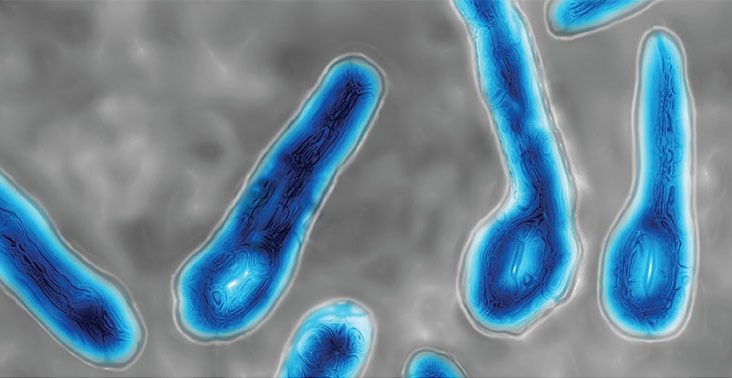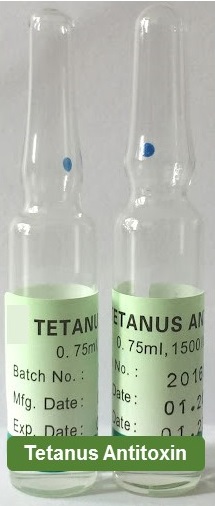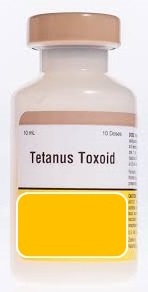Tetanus: What Africans need to know
By: Rukhsar Jabbar. M.Sc. Physiotherapy. Freelance Health Writer. Medical review and editorial support provided by the DLHA Team

A black African newborn baby with tetanus disease. Note arched back and head.
Tetanus is a significant public health concern in Sub-Saharan Africa, with high mortality (death) rates recorded in various countries. For example, estimates show death rates from tetanus is as high as 64% in Nigeria, 47% in Uganda, 43.1% in Tanzania, and 48.5% in Cameroon. The problem is particularly severe for infants, with Somalia, South Sudan, Afghanistan, and Kenya experiencing over 1,000 deaths per 100,000 inhabitants. [1]
Additionally, countries like Somalia, South Sudan, and Kenya have alarmingly high rates of post-neonatal tetanus mortality, with more than five deaths per 100,000 persons. Sadly, nearly half of all tetanus-related deaths among mothers and newborns worldwide occur in Sub-Saharan Africa, highlighting the urgent need for improved vaccination efforts in the region. [2]
The article aims to -
Tetanus is a serious infection typified by intense muscle spasms, particularly in the jaw and neck, due to increased muscle tension. Elderly individuals with weakened immunity or those who haven't been vaccinated are more at risk of this disease.
Fortunately, global immunization efforts have helped reduce tetanus cases worldwide. Tetanus can be categorized into four main types based on clinical observations. [3]
Generalized tetanus is the most common form, accounting for over 80% of cases.
Neonatal tetanus (NT), a subtype of generalized tetanus, affects newborns that lack protective antibodies from their mothers. NT is entirely preventable if women of childbearing age receive recommended vaccinations and follow basic safety measures during childbirth. Transmission occurs when the bacteria causing tetanus come into contact with damaged skin, such as the wound from cutting the umbilical cord. Unclean practices during labor, lack of sterilized delivery instruments, unsanitary conditions, and limited access to healthcare resources increase the risk of NT. [1]
Localized tetanus is a distinct form that may progress to generalized tetanus. Typically, it occurs in individuals with partial immunity to tetanus and it appears as localised and persistent spasms at the site of an injury. It may last for several week and it is rarely fatal. It may however become generalised, at which time it becomes life threatening.
Cephalic (Cerebral) tetanus, the rarest type. It is associated with head and facial injuries or lesions. It may be linked to conditions like otitis media and dental procedures. Early paralysis of muscles of breathing and the vocal cords are common. It also has the potential to develop into generalized tetanus. [3, 4]
Tetanus is caused by the bacteria (germ) called Clostridium tetani (see figure 1). The bacteria is commonly found in dirt, dust, or animal waste. These bacteria thrive in warm, moist environments with organic-rich soil.

fig. 1: Magnified and colour enhanced microscopic image of Clostridium tetani. Credit: James Cavellin/Science source
Humans can get infected through insect bites, cuts, or wounds, especially small ones like thorn spikes or metal splinters.
As the bacteria grows and thrives in a wound, they release a poison (toxin) called tetanospasmin. It is this toxin that attacks the nerves in the body that control muscles
.
The incubation period for tetanus usually ranges from seven to ten days, but it can extend up to sixty days. The severity of symptoms depends on how close the infection is to the central nervous system, with shorter incubation periods often leading to more severe symptoms. [3]
Tetanus remains a major public health issue worldwide, especially in low-income regions (in africa and elsewhere) where environmental and sterile birth practices are poor and vaccination rates are low.
In 2018 alone, about 25,000 infants died from neonatal tetanus. This marks a significant decrease from the predicted 787,000 newborn deaths per month due to tetanus in 1988. However, factors such as declining immunity and limited opportunities for males to receive booster doses in certain countries increase the risk of tetanus among teenage and adult males, as well as particularly those young children who have been circumcised. [5]
Tetanus can affect anyone, but the biggest risk is to unvaccinated and inadequately vaccinated people (infants, young children, expectant mothers, farm and animal workers).
Maternal tetanus occurs during pregnancy or within six weeks after giving birth, while neonatal tetanus strikes within the first 28 days of a baby's life. [5]
The risk factors for neonatal tetanus include the following: [3]
The risk factors for adolescents and older adults include: [3]
These include:
Typically, trismus manifests as the initial symptom, followed by spasms in the remaining body parts. Most patients have reflex spasms, which can be brought on by innocuous external stimuli like light, touch, or noise. [3]
As the disease progresses, additional signs and symptoms may include:
Tetanus diagnosis doesn't usually require lab tests. Doctors rely on observing clinical symptoms instead.
According to the World Health Organization (WHO), neonatal tetanus is confirmed when a newborn, who initially can suckle and cry normally in the first two days of life, suddenly loses this ability between days three and twenty-eight, showing rigidity or spasms instead.
For non-neonatal tetanus, the WHO states that a person must display either painful muscle contractions or a prolonged facial spasm resembling a smile. While a history of injury or wound is typically needed for this diagnosis, tetanus can sometimes affect individuals without a specific identifiable lesion. [5]
 Treatment of Tetanus
Treatment of Tetanus The severity of the disease determines how tetanus is treated. Nonetheless, the following treatments are offered to every patient.
The time between the start of symptoms and the first muscle spasm plays a crucial role in predicting the outcome of tetanus. If symptoms appear rapidly, the prognosis is generally poor. Recovery from tetanus can be slow, often taking several months, especially for cases of cephalic and newborn tetanus where the outlook is not often favourable.
Some individuals may experience muscle weakness and problems with the control of urine and bowel movements (I.e., autonomic nervous system function) for months or even years after recovering from tetanus. Tetanus toxoid vaccination is essential for survivors because the illness does not provide immunity. Although the road to recovery can be lengthy, most patients ultimately survive. Some may not fully regain their previous health. [3]
The complications associated with tetanus include:

TT shots are typically given in the thigh or upper arm and are considered safe, with minimal side effects. [7]
Tetanus isn't contagious between people. It typically occurs through skin cuts and wounds that are contaminated with dirt or soil that harbours the germs (bacteria) causing the disease. Deep punctures from things like wood splinters, knives, rusted nails or animal bites can carry tetanus bacteria. When the bacteria infects the body and multiplies, they release a potent toxin (tetanospasmin), that causes all the symptoms associated with the disease like muscle stiffness and spasms.
Apart from supportive care, specific treatment of tetanus include the use of passive immune agents (tetanus immunoglobulin), which contains antibodies that destroy the bacteria, offering immediate but temporary protection. If you haven't completed your tetanus vaccination, doctors may recommend Tetanus Toxoid vaccination alongside the immunoglobulin for long-term protection. [7]
1. Do?an A, Mohamed Al? A, Abdullahi Al? M, Orul H. Assessment of tetanus Immunization among healthcare workers in Mogadishu, Somalia. Hum Vaccin Immunother. 2023 Dec 31;19(1):2202128. doi: 10.1080/21645515.2023.2202128. Available from here.
2. Cleveland Clinic. Tetanus Shot: Purpose [Internet 2022 Oct. 11] Cited 2024 June 6. Available from here.
3. Bae, Crystal, and Daniele Bourget. “Tetanus.” StatPearls, StatPearls Publishing. [Internet. Last updated 2023 Mar. 31] Cited 2024 June 6. Available from here.
4. CDC. Tetanus: Clinical Features of Tetanus. [Internet. 2024 Mar. 4]. Cited 2024 June 6. Available from here.
5. World Health Organization (WHO). Tetanus. [Internet 2023 Aug. 24]. Cited 2024 June 6. Available from here.
6. WHO Regional Office for Africa. Maternal and neonatal tetanus. [Internet, n.d.]. Cited 2024 Jun 6. Available from here.
7. WHO Regional Office for Africa. Tetanus. [Internet, n.d.]. Cited 2024 Jun 6. Available from here.
Published: June 12, 2024
© 2024. Datelinehealth Africa Inc. All rights reserved.
Permission is given to copy, use and share content for non-commercial purposes without alteration or modification and subject to source attribution.
DATELINEHEALTH AFRICA INC., is a digital publisher for informational and educational purposes and does not offer personal medical care and advice. If you have a medical problem needing routine or emergency attention, call your doctor or local emergency services immediately, or visit the nearest emergency room or the nearest hospital. You should consult your professional healthcare provider before starting any nutrition, diet, exercise, fitness, medical or wellness program mentioned or referenced in the DatelinehealthAfrica website. Click here for more disclaimer notice.